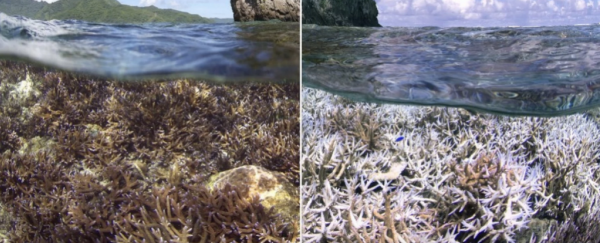For the third time in recorded history, a severe coral bleaching event is set to damage 38 percent of the world's reefs, and researchers warn that the rising ocean temperatures responsible could bring on unprecedented destruction.
Spanning from Hawaii to the Indian Ocean, the bleaching is expected to destroy 12,000 square kilometres of coral this year, with the possibility of spreading even further in 2016. A deadly combination of a monster El Nino event, the large 'blob' of warm water circulating through the Pacific Ocean, and the effects of global warming has been blamed for the bleaching event, which will likely last for at least the next couple of years.
A consortium of researchers from the US National Oceanic and Atmospheric Administration (NOAA), the XL Catlin Seaview Survey, the University of Queensland in Australia, and Reef Check made these predictions based on a new study that used models to map out the movement of the bleaching event, and field observations of the affected areas.
"This is only the third time we've seen what we would refer to as a global bleaching event, an event that causes mass bleaching in the Indian Ocean, the Pacific Ocean, and the Atlantic-Caribbean basin," head of NOAA's Coral Reef Watch, Mark Eakin, told Chris Mooney at The Washington Post.
So far, coral bleaching has been reported throughout the northern Pacific, Indian, and western Atlantic Oceans, and the Caribbean is expected to show signs of damage in the coming weeks. For a bleaching event to be classified as 'global', it needs to affect all three major ocean basins and at least 100 kilometres of coral reefs.
The two previous global events occurred as recently as 1998 and 2010, and while they were both devastating to coral populations - in 1998, 16 percent of the world's corals and 10 percent of the Great Barrier Reef population were wiped out - what's concerning about the current event is how long it's likely to drag on.
Right now, the researchers are saying we're set to lose 5 percent of the world's coral in 2015, but the destruction will only get worse the longer the bleaching continues into 2016. "We're looking at a similar spatial scale of bleaching across the globe, but spanning across at least two years," said Eakin. "So that means a lot of these corals are being put under really prolonged stress, or are being hit two years in a row."
Coral bleaching takes place when ocean temperatures heat up and stress out corals so much, they evict the algae that live inside them and give them their colour. The problem is, these algae also provide the corals with nutrients, which means they're left vulnerable in conditions they haven't evolved to deal with, and often die out.
Naturally, how severe and prolonged the warming is affects how long coral populations can hold out and recover. According to The Sydney Morning Herald, waters on the surface of the eastern Pacific Ocean and around the equator have warmed by as much as 4 degrees Celsius, thanks to El Nino, and deeper down, certain areas are up to 7 degrees warmer.
Not only will corals in Australia's Great Barrier Reef be affected by the current event, the NOAA predicts that 95 percent of all US coral reefs will be affected in the next 12 months, with 60 percent of them expected to be "hit with severe thermal stress and we're going to see a lot of corals dying", Eakin told The Washington Post.
